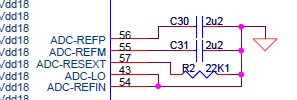Hello!
I am having issues properly grounding the ADC module on the F28335. The chip does NOT appear to use analog ground by 'default', unfortunately; any of the values I read off are inconsistent and noisy. While I know the ADC must be properly grounded (ie: connected to analog ground), I am using the F28335 ( more specifically: http://www.ti.com/product/tms320f28335 ) in conjunction with the USB R2 docking station. Unfortunately, this docking station does not have the proper pin (#43, ADCLO / ADC ground) "pulled out", and hence it is impossible to reach. (see page 25 of this document, look for "ADCLO": http://www.ti.com/lit/ds/symlink/tms320f28335.pdf ). According to the manual, the GPIO pins may be configured for a setting called ADCSOC (see Table 4-17, page 104 of the same document).
Does anyone know if the GPIO pins can be configured to serve as ground for the ADC? Or, more generally, is anyone aware of how to properly ground the ADC on this board, which does not pull out the ADCLO pin?
Thanks a bunch for any help, advice, or additional documentation!
Best wishes,
Patrick



